Coming toward the end of my time at OSC, I was aware that I had not done my CAS Project yet. An essential requirement which allows me to graduate. Sitting in math one day, Ms. Fleming, the high school counselor, comes into class and leaves a note on my desk saying “If you haven’t done your CAS Project yet, come see me after class. I have the perfect idea.”. Naturally my curiosity level sky rocketed. I saw her after class and she pitched me the idea. That Friday for our CAS/SAC block, they were planning a car maintenance workshop and unfortunately, the person who was going to be teaching that class had cancelled last minute. Me being the grade car guru, Ms. Fleming asked me to not only fill in but also make this my CAS Project. So began the journey.
Ms. Fleming and I spent the first block of the next day planning out what I would be teaching. I suggested that the school mechanic, Mr. Priyal, should be the one who demonstrates how to change a tire as he is more experienced than I am, whereas I would be teaching my peers on how to perform basic car maintenance. We would be using 3 vehicles in total. Mr. Eagle’s car ( A Perodua Bezza) would be used for the demonstration of how to change a tire. Ms. Haseena’s car (A Kia Picanto) would be used for the basic car maintenance workshop, and a school van (A Toyota Hiace) would be used along side Ms Haseena’s car in order to show small parts of the engine bay more easily as it was more opened out. Sitting in the student center, Ms. Fleming and I tried to come up with an acronym that would make it easier for my peers to remember. After a few minutes of brain storming, it struck me. ELFFTOWJ.
E – Exhaust (Make sure it isn’t plugged)
L – Lights (Make sure they are all working properly)
F – Fuel (Make sure you have enough to make your journey)
F – Fluids (Brake fluid, washer fluid, radiator coolant)
T – Tire Pressures (Make sure you have a sufficient amount)
O – Oil (Check your engine oil to make sure it is within the vehicle’s minimum requirements)
W – Wipers (Make sure they are in good condition)
J – Jumper Cables (Make sure you have them in your car)
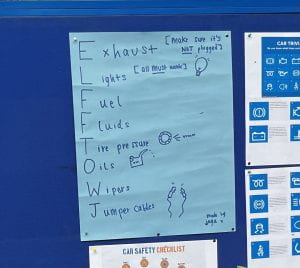
That Friday morning, I arrived in school early to get set up along with Ms. Fleming. The cars were all parked in the parking lot near the gym. I would be teaching 4 different groups. I was slightly nervous about how my teaching skills would be, or whether or not I would have been taken seriously as I was a student in the same grade as the pupils. Thankfully, I can confidently say my peers were very corporative and supportive of the lesson I was given as I was already known to be extremely passionate about cars throughout my time at OSC.
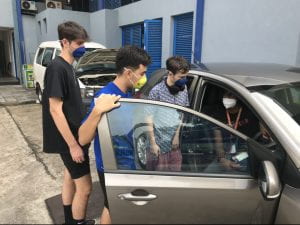
Starting off with the first group, I definitely felt somewhat anxious about how I would be speaking, whether or not I would be easy to understand, and so on. As I finished up with the first group, I felt less anxious and keen to move on to the next group as my confidence in explaining certain things had risen and I was feeling more comfortable and settled.
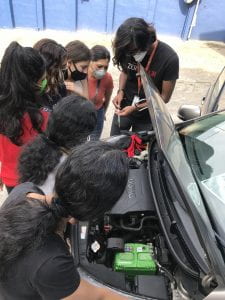
During the second session of teaching, I borrowed a cloth from the maintenance department to show how to check the oil more effectively as well as show where on the engine dip-stick the minimum and maximum levels of oil are located.

Towards the end of each group session, I demonstrated how to safely perform a jump start (When your car battery goes dead). I felt most confident explaining this aspect as I have a large amount of experience jump starting vehicles and was able to apply this knowledge effectively during the lesson. Along with explaining the equipment that would be needed to perform a jump start, I prioritized the safety precautions that should be taken when performing a jump start in order to minimize the chance of being electrocuted or causing a fire.
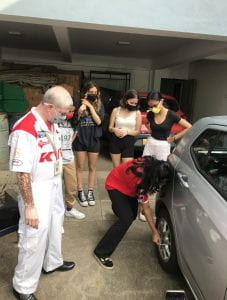
As I taught the final group, I reflected back on my brief time as a “teacher” and was satisfied. I was grateful to my peers for being corporative and attentive during the lesson and for having faith in my teaching prowess. I feel my confidence in speaking publicly was definitely improved and enhanced. I got to know my peers on a new level and speak to them on a more relatable level.
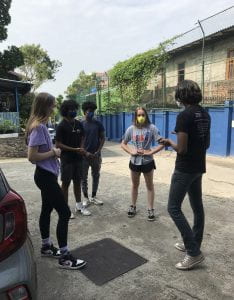
To conclude, I loved the process of sharing my interest in cars with my whole class and being able to provide them with a service in helping them learn how to perform basic car maintenance. I am very grateful to Ms. Fleming (The High School Counselor), Mr Lockwood (CAS Coordinator) and Mr. Duncan (DP Coordinator) for giving me this opportunity to showcase my knowledge and interest in the form of the car maintenance work shop and also giving me the idea to make this my CAS Project.
LO1 – Identify own strengths and develop areas for growth
Students are able to see themselves as individuals with various abilities and skills, of which some are more developed than others.
LO3 – Demonstrate how to initiate and plan a CAS experience
Students can articulate the stages from conceiving an idea to executing a plan for a CAS experience or series of CAS experiences. This may be accomplished in collaboration with other participants. Students may show their knowledge and awareness by building on a previous experience, or by launching a new idea or process.
LO5 – Demonstrate the skills and recognize the benefits of working collaboratively
Students are able to identify, demonstrate and critically discuss the benefits and challenges of collaboration gained through CAS experiences.